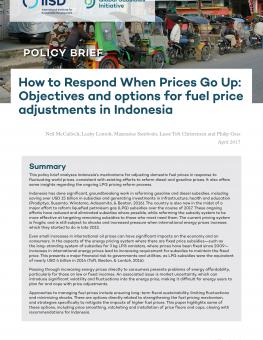
How to Respond When Prices Go Up: Objectives and options for fuel price adjustments in Indonesia
There are options to strengthen the fuel pricing mechanism in Indonesia. This policy brief highlights some options, including price smoothing, ratcheting and installation of price floors and caps, closing with recommendations.
This policy brief analyzes Indonesia’s mechanisms for adjusting domestic fuel prices in response to fluctuating world prices, consistent with existing efforts to reform diesel and gasoline prices. It also offers some insights regarding the ongoing LPG pricing reform process.
Indonesia has done significant, ground-breaking work in reforming gasoline and diesel subsidies, including saving over USD 15 billion in subsidies and generating investments in infrastructure, health and education. The country is also now in the midst of a major effort to reform liquefied petroleum gas (LPG) subsidies over the course of 2017. These ongoing efforts have reduced and eliminated subsidies where possible, while reforming the subsidy system to be more effective at targeting remaining subsidies to those who most need them. The current pricing system is fragile, and is still subject to shocks and increased pressure when international energy prices increase, which they started to do in late 2015.
Even small increases in international oil prices can have significant impacts on the economy and on consumers. In the aspects of the energy pricing system where there are fixed price subsidies—such as the long-standing system of subsidies for 3 kg LPG canisters, where prices have been fixed since 2009— increases in international energy prices lead to increasing requirement for subsidies to maintain the fixed price. This presents a major financial risk to governments and utilities, as LPG subsidies were the equivalent of nearly USD 4 billion in 2014.
Passing through increasing energy prices directly to consumers presents problems of energy affordability, particularly for those on low or fixed incomes. An associated issue is market uncertainty, which can introduce significant volatility and fluctuations into the energy price, making it difficult for energy users to plan for and cope with price adjustments.
Approaches to managing fuel prices include ensuring long-term fiscal sustainability, limiting fluctuations and minimizing shocks. There are options directly related to strengthening the fuel pricing mechanism, and strategies specifically to mitigate the impacts of higher fuel prices. This paper highlights some of these options, including price smoothing, ratcheting and installation of price floors and caps, closing with recommendations for Indonesia.
Participating experts
You might also be interested in
South African Fossil Fuel Subsidies Hit Record Highs as Country's Energy Crisis Deepens
South Africa's fossil fuel subsidies tripled between 2018 and 2023, hitting USD 7.5 billion, up from USD 2.9 billion 5 years earlier, a new report by IISD reveals.
Blackouts and Backsliding: Energy subsidies in South Africa 2023
Blackouts and Backsliding presents the latest energy subsidy data for South Africa.
Copenhagen Climate Ministerial: Expert comment
Around 40 climate leaders and ministers are meeting in Copenhagen from March 21 to 22 to discuss priorities for COP 29.
India Faces Clean Energy Challenges as Energy Demand Soars and Global Fossil Fuel Subsidies Rise
New research finds the global energy crisis and increasing energy demand have pushed India's energy subsidies to a 9-year high.